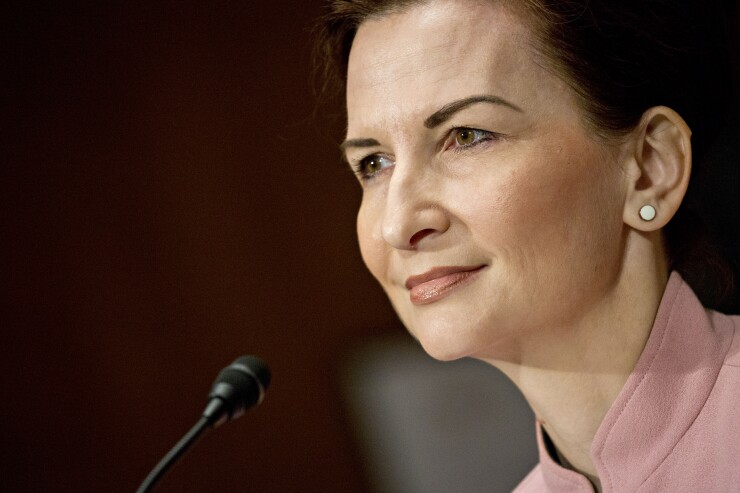The 1989 Federal Deposit Insurance Act was created in a different time for a different world. Banking has changed so drastically in the past 30 years that it would be hardly recognizable to someone from that era. With the rise of technology, a truly global economy and an ever more informed and savvy consumer, funding bank operations these days is less and less about customer loyalty.
Banks are, and will be, more and more dependent on funds not raised from their local market. More specifically, banks that have “net borrowers” — customers that the Federal Deposit Insurance Corp. would call unbanked or underbanked — as their primary clientele will certainly be dependent on funds from sources other than their deposit base.
In our small bank, we have opened 3,500 free checking accounts in the last five years and the average balance on those accounts is $700. During that time we have originated 4,500 consumer loans with an average balance of $10,000. You can’t make it up on volume.

The problem with the current regulatory outlook on brokered deposits in general and the rate cap in particular, as outlined in Section 29 of the 1989 FDIA, is that banks who seek to serve the unbanked and the underbanked will be very dependent on funds from sources outside of their deposit base — and yet regulators have attached a stigma to funding bank operations from such sources. They view banks with a high level of funding from these sources as necessarily risky and one of the main responses to this risk is the rate cap that the FDIC may impose on a bank if it is deemed less than “well capitalized.”
Currently, the rate cap is calculated using a complex and flawed methodology. They take all of the rate sheet offerings in every term of all the banks in the nation and average them and then add 75 basis points (0.75%) to the rate. As of this writing, the rate cap for jumbo 12-month CDs is 1.30%. There are many reasons this calculation is flawed, but the simplest reason is that the average rate is calculated by looking at all of the “bids” for money and not just all “winning bids” for money.
If I wanted to determine the average price of iPads on eBay I could look at an auction and average all of the bids for an iPad. There may have been 100 bids for an iPad, the average bid being $54, but the winning bid at $260 is the price at which the iPad sold. The calculation of $54 being the average bid might be mathematically correct, but it tells me nothing about the price of iPads, nor does the way the FDIC calculates the average bid for money tell anything meaningful about the market price for money.
The second most compelling reason that their methodology is flawed is that the current one-year Treasury rate is 2.70% while the rate cap is about half of that. I’m tempted to drop my mic and go home, but just to make sure this point is clear, I shall press on. The Treasury rate, I learned in my Econ 101 class, is the “risk-free rate,” meaning that Treasurys will likely be the lowest rate you should expect to get for a fixed-income investment for a given period of time. If the current FDIC rate cap is half of what Treasurys are paying, there is a serious problem with the rate-cap methodology.
Some bankers may think, “Why does this matter to me? I’m not in any danger of being put under the rate cap, and besides, I don’t have any brokered money that I use to fund my bank.” It’s a fair argument, but if an institution were to be deemed less than “well capitalized,” the rate caps would be in effect for what a bank could pay local customers as well. When the rate cap is imposed, it looks at all deposits as “brokered” meaning that a bank can’t even do CD specials to their community at rates that are above the cap.
All banks have a stake in this matter because getting in moderate trouble could cause the rate cap to be imposed and may drastically change the way the bank is run. Another reason all banks should be concerned about it is that examiners may want scenarios to be run assuming the rate cap is in force, and if those scenarios aren’t pretty, it could be further grounds for criticism. In addition to banks having a stake in this issue, the FDIC has a stake in it because if a significant number of banks were put under the rate cap, they could fail and pose a threat to the Deposit Insurance Fund. Of course, the healthy banks would be on the hook to replenish the fund as in the 2008 aftermath.
The FDIC has gone to great lengths with CRA rules and regulations to encourage banking the unbanked and the underbanked. But with antiquated regulations on funding and a hopelessly flawed methodology for determining what constitutes an excessive rate of interest, the banks that are seeking to fulfill the mandate of serving the underserved may be put in a position of having to decide whether to serve them or to be in a position to survive if they get put under the rate cap. Given the power of the FDIC and the examiners on the ground, the fate of some banks could be in their hands. The rate cap could turn out to be a self-fulfilling prophecy in which the success or failure of banks is determined by their ability or inability to survive having the flawed rate cap imposed. If the primary risk to these institutions is the FDIC rate-cap rule itself, shouldn’t they seriously reconsider it altogether?





